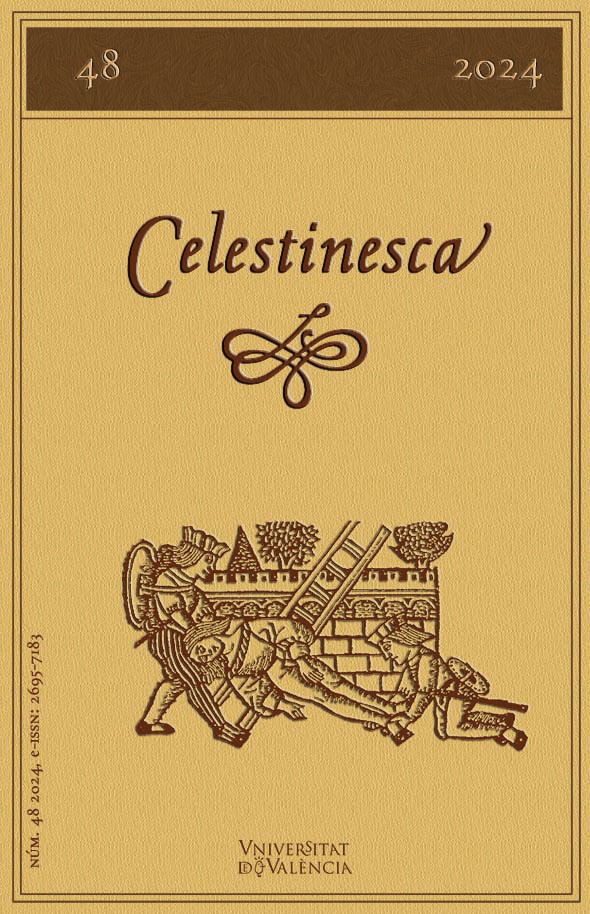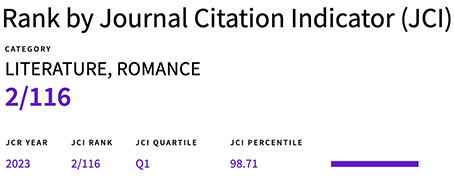Voice art and listening: the performative discourse in the Comedy/Tragicomedy of Calisto and Melibea
DOI:
https://doi.org/10.7203/Celestinesca.48.28679Keywords:
Voice, Listening, Performative text, Performance, Psychodynamics oral and written Abstract
Abstract
Between the 13th and 17th centuries, the interweavings of the oral and written psychodynamics gave birth to new production, transmission, and textual reception techniques that frame hispanic literature. Conceived as sensitive objects, literary texts served as sheet music due to their inherent theatricality –which was mastered in Spanish Golden Age theatre stagings–, destined towards minstrel’s vocal-gestural performances, bards, and through time, public readers. The aformentioned theatricality lies coded in the “performative text”, which instructs the voice, the gesture, the space and time of the virtual performances, and it is diseminated within the narration and dialogue –it being verse or prose– of a literary corpus that encompasses half a millenium. Inadvertently deturped in modern editions, this discourse absorbs the rhetoric actio, pragmatic signs, as well as numerous didascalias attributed to dramatic texts. Unusually complex and original in the case of the Comedia/Tragicomedia de Calisto y Melibea, the performative text responds to the necessity of making in thirteen voices dialogue intelligible to the vocal reader as well as to the listeners, parallely having an intricated plot and without the narrator’s support. In the present article, cues for performativity are indentified througout the text and its functions analyzed, within the autos’ arguments, in paradigmatic dialogues, –e.g. both of Celestina and Melibea–, in vocalization techniques –soliloquy and asides– or in the vicissitudes of listening, e.g. those that lead Celestina towards her death. Ultimately, whenever it became conspicuous, the performative text created a different textual meaning in contrast to the one which is obtained today by the hermeneutics of silent reading.
 Downloads
Downloads
 References
References
Baldwin, Spurgeon W. Jr. (1967-1968), «"En tan pocas palabras" (La Celestina, Auto IV)», Romance Notes, 9, pp. 120-125.
Bataillon, Marcel (1961), «La Célestine» selon Fernando de Rojas, Paris, Didier.
Candelas Colodrón, Manuel Ángel (2003), «Modelos dispositivos del diálogo en el siglo XVI español», Hesperia. Anuario de Filología Hispánica, 6, pp. 57-78. En línea: https://revistas.uvigo.es/index.php/AFH/article/view/425 [consultado el 01/08/2024].
Canet Vallés, José Luis (2008), «Género y dramaturgia en la Celestina», en Theatralia. La dramaturgia de «La Celestina», eds. José María Ruano de la Haza y Jesús G. Maestro, Vigo, Editorial Academia del Hispanismo, pp. 27-42.
Cantar de Mio Cid (2014), ed. Alberto Montaner, México, Academia Mexicana de la Lengua.
Cassan Moudoud, Chantal (1987), «El uso de los apartes en Celestina», Celestinesca, 11, 1, pp. 13-20. https://doi.org/10.7203/Celestinesca.11.19649
Cervantes Saavedra, Miguel de (1617), Los trabajos de Persiles, y Sigismunda, historia Setentrional, Juan de la Cuesta, Madrid.
Chartier, Roger (2003), «El concepto de lector moderno», en Historia de la edición y de la lectura en España. 1472-1914, eds. Víctor Infantes et al., Madrid, Fundación Germán Sánchez Ruipérez, pp. 142-149.
Coleman, Joyce (1996), Public Reading and the Reading Public in Late Medieval England and France, Cambridge, Cambridge University Press.
Coronado Schwindt, Gisela (2020), «Los estudios sensoriales y la Edad Media: planteos historiográficos, desafíos y proyecciones», Revista de historiografía, 34, pp. 277-298. https://doi.org/10.20318/revhisto.2020.4830
Covarrubias, Sebastián de (1993), Tesoro de la Lengua Castellana o Española, ed. Martín de Riquer, Barcelona, Alta Fulla.
Frenk, Margit (1982), «"Lectores y oidores". La difusión oral de la literatura en el Siglo de Oro», en Actas del Séptimo Congreso de la Asociación Internacional de Hispanistas, vol. 1, ed. Giuseppe Bellini, Roma, Bulzoni, pp. 101-123.
Frenk, Margit, (1984), «Ver, oír, leer», en Homenaje a Ana María Barrenechea, eds. Lía Schwartz Lerner e Isaías Lerner, Madrid, Castalia, pp. 235-240.
Frenk, Margit, (2005), Entre la voz y el silencio. La lectura en tiempos de Cervantes, México, D. F., Fondo de Cultura Económica.
Gifford, D. J. (1981), «Magical Patter: The Place of Verbal Fascination in La Celestina», en Medieval and Renaissance Studies on Spain and Portugal in Honor of. P.E. Russell, eds. F. W. Hodcroft, D. G. Pattison, R. D. F. Pring-Mill y R. W. Truman, Oxford, The Society for the Study of Medieval Language and Literature, pp. 30-37.
Gilman, Stephen (1978 [1972]), La España de Fernando de Rojas. Panorama intelectual y social de «La Celestina», trad. Pedro Rodríguez Santidrián, Madrid, Taurus.
Hita, Arcipreste de (2001), Libro de buen amor, ed. G. B. Gybbon-Monypenny, Madrid, Castalia.
Illades Aguiar, Gustavo (2022), La «ecuación voz-escritura» en las letras hispánicas (del «Cantar de Mio Cid» al «Quijote» y el «Persiles»), Zaragoza, España, Libros Pórtico.
Las Siete Partidas del Sabio Rey Don Alfonso el IX [sic] (1843-1844), eds. Ignacio Sanponts y Barba, Ramón Martí de Eixala y José Ferrer y Subirana, Barcelona, Imprenta de Antonio Bergnes.
Libro de Alexandre (1987), ed. Francisco Marcos Marín, Madrid, Alianza Editorial.
Lida de Malkiel, María Rosa (1970), La originalidad artística de «La Celestina», Buenos Aires, EUDEBA.
Lloret, Albert (2007), «El error retórico de la alcahueta. Performatividad y nueva retórica en la Celestina», Celestinesca, 31, pp. 119-132. https://doi.org/10.7203/Celestinesca.31.20073
Maurizi, Françoise (1997), «"Dize el modo que se ha de tener leyendo esta (tragi) comedia": breve aproximación al paratexto de La Celestina», Bulletin of Hispanic Studies 74, 2, pp. 151-157. https://doi.org/10.3828/bhs.74.2.151
Morgan, Erica (1979), «Rhetorical Technique in the Persuasion of Melibea», Celestinesca, 3, 2, pp. 7-18. https://doi.org/10.7203/Celestinesca.3.19493
Ong, Walter J. (1999 [1982]), Oralidad y escritura. Tecnologías de la palabra, trad. Angélica Scherp, México, D. F., Fondo de Cultura Económica.
Poema de Mio Cid (1984), ed. Ian Michael, Madrid, Castalia.
Rallo Gruss, Asunción (1992), «La confluencia de los géneros: reflexiones sobre la autonomía del diálogo renacentista», Ínsula, 542, pp. 14-15.
Read, M. K. (1978), «Fernando de Rojas's Vision of the Birth and Death of Language», Modern Language Notes, 93, 1-3, pp. 163-175.
Rojas, Fernando de (¿1499?), Comedia de Calisto y Melibea, Fadrique Alemán de Basilea, Burgos.
Rojas, Fernando de, (1987), La Celestina, ed. Doroty S. Severin, Madrid, Cátedra.
Rojas, Fernando de, (1991), Comedia o Tragicomedia de Calisto y Melibea, ed. Peter E. Russell, Madrid, Castalia.
Scarborough, Connie L. (2012), «Speaking of Celestina: Soliloquy and Monologue in the Tragicomedia de Calisto y Melibea», Celestinesca, 36, pp. 209-236. https://doi.org/10.7203/Celestinesca.36.20153
Snow, Joseph T. (2002), «Quinientos años de animadversión entre Celestina y Pleberio: postulados y perspectivas», en Visiones y crónicas medievales. Actas de la VII Jornadas Medievales, eds. Aurelio González, Lillian von der Walde y Concepción Company, México, Universidad Nacional Autónoma de México/Universidad Autónoma Metropolitana/El Colegio de México, pp. 13-29.
Suárez Coalla, Francisca (1989-1990), «La función de los apartes en el discurso dialógico de La Celestina», Archivum: Revista de la Facultad de Filosofía y Letras, 39-40, pp. 469-484. En línea: https://reunido.uniovi.es/index.php/RFF/article/view/1778 [consultado el 01/08/2024].
Talavera, Fray Hernando de (1911), Tractado muy provechoso contra el común é muy continuo pecado que es detraher ó murmumar y decir mal de alguno en su absencia, en Escritores místicos españoles, Nueva Biblioteca de Autores Españoles 16, Madrid, Bailly-Bailliére, pp. 47-56.
Tragicomedia de Calisto y Melibea (1999), [Valencia, Juan Joffre, 1514], ed. paleográfica Nicasio Salvador Miguel y Santiago López-Ríos, Valencia, Institució Alfons el Magnànim/Ministerio de Educación y Cultura/Biblioteca Nacional.
Urbina Fonturbel, Raúl (2016), «Nuclearidad pragmática y poliacroasis discursiva en los apartes de La Celestina», Dialogía: revista de lingüística, literatura y cultura, 10, pp. 180-216. En línea: https://journals.uio.no/Dialogia/article/view/4017 [consultado el 01/08/2024].
Vian Herrero, Ana (1992), «El diálogo como género literario argumentativo: imitación poética e imitación dialógica», Ínsula, 542, pp. 7-10.
Zimmerman, Marie-Claire (1995), «Le dire dans La Célestine: pouvoir, plaisir et solitude», en «La Célestine. Comedia o Tragicomedia de Calisto y Melibea». Actes du Colloque International du 29-30 Janvier 1993, ed. Françoise Maurizi, Travaux et Documents 2, Caen, Université-Maison de la Recherche en Sciences Humaines, pp. 145-166.
Zumthor, Paul (1989 [1987]), La letra y la voz. De la «literatura» medieval, trad. Julián Presa, Madrid, Cátedra.
Downloads
Published
How to Cite
-
Abstract91
-
PDF (Español)50
Issue
Section
License
Copyright (c) 2024 Gustavo Illades Aguiar

This work is licensed under a Creative Commons Attribution-NonCommercial-NoDerivatives 4.0 International License.
![]() Celestinesca is committed to the dissemination of knowledge, that is why access to its contents is free and is ruled by a Creative Commons Attribution-NonCommercial-NoDerivatives 4.0 license.
Celestinesca is committed to the dissemination of knowledge, that is why access to its contents is free and is ruled by a Creative Commons Attribution-NonCommercial-NoDerivatives 4.0 license.
Authors retain the rights to their works. Therefore, they can disseminate them and deposit them in the repository, institutional or not, that they wish. However, they are kindly requested to do so by providing the full bibliographic reference and the corresponding DOI.
Celestinesca does not charge authors for submitting, processing, reviewing or publishing their articles.





